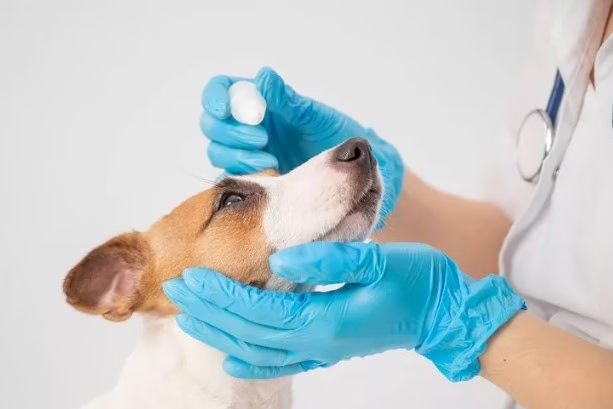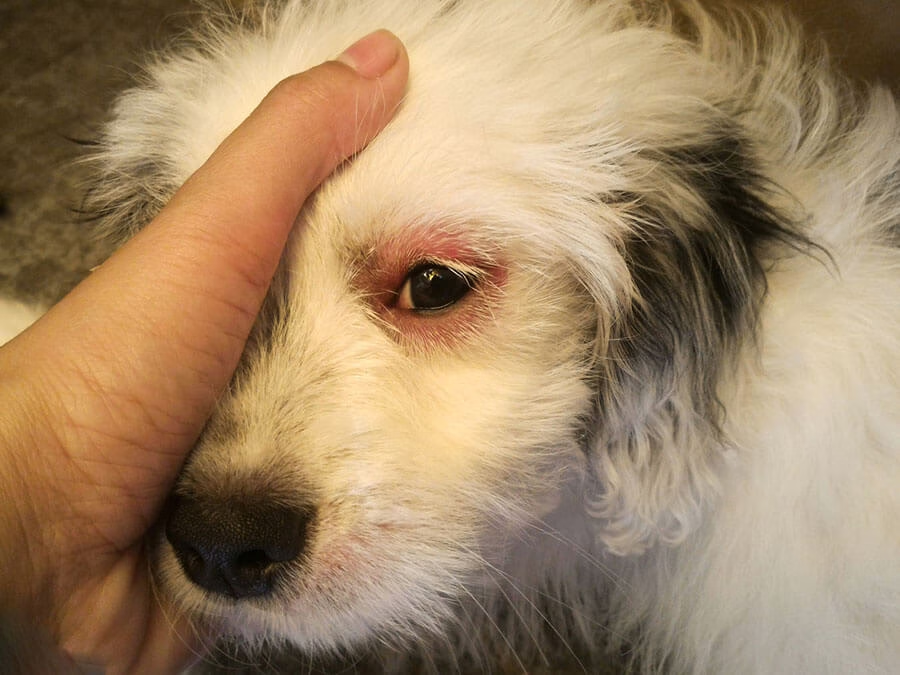Dog Eye Infection – Causes & Treatments Option
Introduction
Dog eye infections are a common but often overlooked health issue that can lead to serious discomfort and even vision loss if left untreated. Just like humans, dogs are susceptible to various types of eye infections caused by bacteria, viruses, allergens, or foreign particles. These infections can develop quickly and may be painful for your pet, so early detection and proper treatment are essential. You might notice signs like redness, discharge, swelling, or excessive blinking—all of which should never be ignored. Understanding the causes, symptoms, and treatment options for dog eye infections can help you act swiftly and responsibly when your furry friend is in distress.
Whether it’s a mild case of conjunctivitis or a more serious condition affecting deeper eye structures, timely intervention can make a significant difference. In this guide, we’ll walk you through everything you need to know about identifying, managing, and preventing eye infections in dogs.
What Is a Dog Eye Infection?

A dog eye infection occurs when harmful microorganisms such as bacteria, viruses, or fungi invade the eye, leading to inflammation, discomfort, and visible symptoms. These infections can affect different parts of the eye, including the conjunctiva (the pink tissue around the eyeball), cornea, or tear ducts. While some infections are mild and easily treatable, others can become serious if not addressed quickly. It’s important for pet owners to recognize the signs early and consult a veterinarian for accurate diagnosis and treatment.
Types of Dog Eye Infections
There are several types of eye infections that can affect dogs, each with unique causes and symptoms. Conjunctivitis, or “pink eye,” is one of the most common and can be triggered by allergies, irritants, or bacteria. Other types include keratitis (corneal inflammation), uveitis (inflammation inside the eye), and infections caused by blocked tear ducts. Some breeds are more prone to certain eye conditions due to facial structure or genetic predisposition. Accurate diagnosis is essential for effective treatment.
Common Causes of Dog Eye Infections
Dog eye infections can be triggered by a variety of factors. Bacterial and viral infections are among the most common causes, often resulting from exposure to contaminated environments or contact with infected animals. Allergies to pollen, dust, or certain foods can also inflame the eyes and lead to secondary infections. Foreign bodies like dirt, grass seeds, or debris can scratch the eye surface, creating an entry point for infection. Injuries, underlying health conditions, or breed-specific anatomical features—such as bulging eyes—may also increase susceptibility.
Symptoms of Eye Infections in Dogs
Recognizing the symptoms of an eye infection early can prevent complications. Common signs include redness, swelling, and excessive tearing or discharge that may be clear, yellow, or green. dog eye infection may squint, blink excessively, or paw at their eyes due to discomfort. In more severe cases, the eye might appear cloudy, or the dog could show sensitivity to light. Any noticeable change in your dog’s eyes or behavior warrants veterinary attention.
How Vets Diagnose Dog Eye Infections

Veterinarians use a combination of visual inspection and diagnostic tools to accurately identify eye infections in dogs. During the exam, the vet will check for swelling, discharge, cloudiness, and any signs of trauma or irritation. Special tests may include fluorescein staining, which highlights corneal scratches or ulcers, and tear production tests to rule out dry eye. In some cases, a sample of eye discharge may be taken for laboratory analysis to determine the exact cause—bacterial, viral, or fungal—so the most effective treatment can be prescribed.
Treatment Options for Dog Eye Infections
Treatment for dog eye infections depends on the cause and severity. Mild bacterial infections are often treated with prescription antibiotic eye drops or ointments. If inflammation is present, anti-inflammatory medications may also be prescribed. More serious infections may require oral antibiotics or even surgery if the eye is damaged. It’s crucial not to use human medications on your dog eye infection without veterinary approval, as some substances can worsen the condition or cause further harm.
Risks of Ignoring a Dog’s Eye Infection
Delaying treatment for a dog’s eye infection can lead to serious consequences. What may start as minor irritation can quickly escalate into a more severe condition, such as corneal ulcers, vision impairment, or permanent eye damage. Infections can also spread to other areas of the body, especially if caused by aggressive bacteria. Chronic eye problems may develop, requiring long-term treatment or even surgery. Prompt veterinary care not only relieves your dog’s discomfort but also prevents potentially irreversible damage to their eyesight and overall health.
Can You Treat a Dog Eye Infection at Home?
While minor eye irritation might be managed temporarily with vet-approved saline rinses, true eye infections should never be treated at home without guidance. Misusing over-the-counter drops or applying the wrong treatment can worsen the infection or delay proper care. Only a veterinarian can accurately diagnose the cause and prescribe safe, effective medication. If your dog shows signs of eye infection, home care should be limited to keeping the area clean until professional help is available.
How to Prevent Dog Eye Infections
Preventing eye infections in dogs starts with regular care and attention to their hygiene and environment. Clean around your dog’s eyes gently with a damp, soft cloth to remove dirt and discharge. Keep long hair trimmed around the eyes to prevent irritation. During outdoor activities, especially in dusty or windy conditions, avoid exposure to airborne debris that can enter the eyes. Regular grooming, routine vet check-ups, and addressing allergies or underlying health issues early can all reduce the risk of infection and keep your dog’s eyes healthy.
When to See a Vet Immediately
Certain symptoms require immediate veterinary attention to avoid long-term damage. If your dog’s eye appears very red, swollen, or is producing thick or discolored discharge, don’t wait. Also seek urgent care if your dog eye infection is pawing at the eye constantly, showing signs of vision loss, or if the eye appears cloudy, bleeding, or unusually bulging. Quick action can prevent complications and help your pet recover more comfortably and safely.
Dog Breeds Prone to Eye Infections

Some dog breeds are more prone to eye infections due to their physical characteristics or genetic predispositions. Breeds with prominent or bulging eyes—like Pugs, Shih Tzus, and Bulldogs—are more likely to experience eye injuries and infections because their eyes are more exposed. Long-haired breeds such as Cocker Spaniels and Pekingese may also face higher risks due to hair irritating the eyes if not groomed properly. Understanding your dog’s breed-specific risks can help you take preventive measures and monitor eye health more closely.
Can Dog Eye Infections Spread to Humans or Other Pets?
Most dog eye infections, especially those caused by bacteria or viruses, are species-specific and not contagious to humans. However, in rare cases, certain zoonotic infections—like those caused by parasites or specific bacteria—can potentially pose a risk. It’s always wise to practice good hygiene, such as washing your hands after handling your dog eye infection or cleaning their eyes. Some infections may spread to other pets, so keeping infected animals isolated until they recover is a good precaution.
Home Remedies for Mild Dog Eye Irritations
For minor eye irritations or to provide temporary relief, there are some gentle, veterinarian-approved home remedies that can be helpful. A saline solution can be used to rinse away debris and soothe the eyes, but only if the infection appears mild and there is no sign of severe inflammation or infection. Additionally, keeping your dog’s environment clean and dust-free can help prevent further irritation. Always check with your vet before trying any home remedy to ensure it’s safe and appropriate for your dog’s specific condition.
Importance of Regular Vet Check-Ups for Eye Health
Regular veterinary check-ups are essential for maintaining your dog’s overall health, including eye health. During routine exams, your vet will check for early signs of eye infections, as well as other issues such as cataracts, glaucoma, or dry eye. Catching potential problems early allows for quicker treatment, which can prevent more serious conditions from developing. Ensuring your dog’s vaccinations are up to date can also help protect against certain viral infections that affect the eyes.
Conclusion
Eye infections in dogs are not only uncomfortable but can also lead to serious complications if left untreated. By understanding the causes, symptoms, and treatment options, pet owners can take proactive steps to ensure their dog’s eye health. Regular veterinary check-ups, proper grooming, and attention to environmental and dietary factors play a vital role in preventing eye infections. Early detection is key—if you notice any signs of an eye issue, don’t hesitate to consult a vet. By acting promptly, you can help your dog recover quickly and avoid any long-term vision problems. Keep your pet’s eyes healthy, and they’ll be wagging their tails with comfort and joy.
You Can Also Read: Embark Dog DNA Test: Look at Canine Health and Heritage
FAQS
How do you treat a dog’s eye infection at home?
A simple homemade remedy for irritated eyes is a saline solution made by mixing 1 teaspoon of salt in 1 cup of lukewarm water. Use a cotton ball to gently wipe the affected area. However, if the irritation persists, it’s important to consult a vet.
Can a dog’s eye infection heal on its own?
Will a dog’s eye infection go away on its own? In some cases, mild eye infections in dogs may resolve independently, especially if they are caused by temporary irritants like dust or a mild allergen. However, it is important to remember that many eye infections will clear up without treatment.
What causes eye infections in dogs?
They can be caused by bacteria, viruses, or fungus. Take your dog to the vet if you notice any of these signs: Yellow, green, or red drainage from the eyes. Swelling, crusting, and hair loss on the eyelids.
Can dog eye infection spread to humans?
Viral or bacterial conjunctivitis (pink eye) can spread from dogs to humans, though it is
not common. Allergic conjunctivitis cannot spread from dogs to people or from one person to another person.
Are dog eye infections painful?
Uveitis is the inflammation of the interior portion of the eye, and it can be either the result of a severe eye infection or the result of another condition. Most of the time, the eye will be red and swollen. This condition is also fairly painful. Blood may or may not be present in this type of eye infection.

Greatest Information